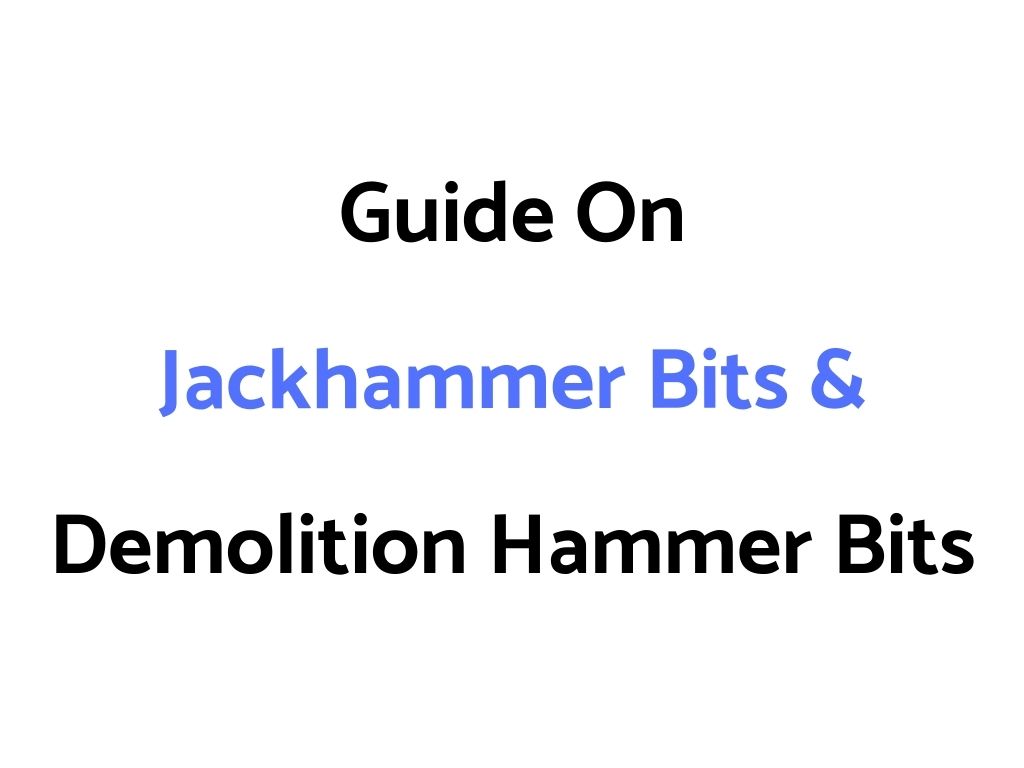So, most demo tool users would be familiar with the common jackhammer bits, and demolition hammer attachments.
Narrow and wide chisels, bull pointed bits, spade attachments & demo drill bits are some of the more frequently used ones.
But, what about other less commonly used bits for specialised tasks and applications?
Here are 15 commonly and not so commonly used jackhammer & demolition hammer bits, and what you can use each bit for:
15 Demolition Hammer & Jackhammer Bits & Attachments, And What They Are Used For
Standard demolition hammer & jackhammer bits are usually 1-1/8″ in diameter, and are made of hard wearing demolition type steel.
Specialty bits can be made ranging between 7/8″ diameter and 1-1/4″.
1. Pointed Bit/Moil Point
A pointed bit is best for general breaking/demolition, and getting into surfaces that need to be separated such as the mortar in brick walls, cracks in concrete, and between stones and rock.
As the name suggests, it has a pointy end.
You can really use a pointed bit for any surface when demolishing:
Tiles
Brick and Masonry
Concrete
Render and stucco walls
Trenching – breaking up stone and rock
Any surface that needs breaking and separating
Pointed bits can be made between 7/8″ diameter and 1-1/4″.
2. Narrow & Wide Tipped Chisels
Chisels have a mitred/angled end, and can be very narrow or up to 3 inches wide at the tip.
Chisels are best for lifting, chipping, peeling and cutting.
Flat chisels are best for chipping and cutting, whilst cranked (angled) chisels are better for lifting and peeling.
Chisel bits are best for tiles, brick and masonry, concrete and render/stucco.
3. Asphalt Cutter Bit
Asphalt cutter bits look like a spade bit, except they have a flat edge/end.
They are designed specifically designed to cut asphalt.
4. Spade Bit
Spade bits look like a shovel and have a rounded end.
They are used for digging and trenching clay, gravel and hard packed earth.
5. Superkut Chisel
Different design to a standard chisel bit, with the angle/mitre of the tip going further up the shank of the chisel than a regular chisel bit.
Superkut chisel bits are used for the same purposes as regular chisel bits, but they give the user faster penetration and require fewer resharpenings than standard narrow and wide chisels.
6. Wedge Bits
Wedge bits have a wedge end/tip, and are used specifically to get into and under surfaces. They are more used for separating and lifting than breaking.
You can use a wedge bit to separate a hard surface, and come in afterwards using a pointed or chisel bit to cut or break the surface down further
Wedge bits come in 2 main types:
Asphalt/Concrete Wedge
Brick Wedge (have a more compact wedge tip specifically to fit into mortar joints)
7. Bushing Tool Bit
Used mainly on concrete surfaces.
A bushing tool bit has a flat end with multiple sharp little spikes/teeth on it.
They are used when high spots or humps are found in slabs, and the bushing tool will flatten out that particular spot.
A practical application for a bushing tool bit is for a tiler demolishing and re-tiling a bathroom. A bushing tool can flatten the existing slab to allow the re-laying of new tiles.
8. Rock Breaker Bit
A cylindrical bit with a flat end.
Designed specifically for breaking rock and stone in the ground.
9. Driver Bits
Driver bits have a cup end.
They are designed to knock/drive particular objects into the ground or into other objects or surfaces by cupping over that object and repeatedly driving/hitting it with force. Some examples of driver bits are:
Concrete Form Pin/Railroad Spike Driver
Pipe Driver
Ground Rod Driver
Sheathing Driver Shoes
Tent Stake Drivers
10. Frost Wedge
Different design to a standard wedge bit, with the wedge tip being much longer up the shank than a regular wedge bit.
Frost wedge bits are used to get a deeper wedge penetration per blow than a standard wedge bit.
11. Digging Chisel
Digging chisels have a flat shank with a flat edge/end.
They are used to cut clay, gravel and hard packed earth in the ground, as opposed to digging it.
12. Splitting Wedges and Shims (also called a plug and feather)
Mainly used for splitting soft stone.
Two shims are placed into the seam/crack, and the wedge is driven through the centre of the shims, separating the stone at the seam.
13. Detachable Shank
Has a rounded type end used to bore holes mainly in softer malleable surfaces like dirt and clay (similar to the theory of how boring piles works)
14. Combo Cutter
Similar to an asphalt cutter bit, but can be used for cutting multiple surfaces.
15. Tamping Pads
A flat bit used to compact dirt, gravel and soil.
Demolition Hammer and Jackhammer Bits – Resources
1. https://tooljuice.com/best-demolition-hammer-jackhammer-buyers-guide-reviews/
